Kenneth D. Forbus
Knowledge Management in the Companion Cognitive Architecture
Jul 08, 2024

Abstract:One of the fundamental aspects of cognitive architectures is their ability to encode and manipulate knowledge. Without a consistent, well-designed, and scalable knowledge management scheme, an architecture will be unable to move past toy problems and tackle the broader problems of cognition. In this paper, we document some of the challenges we have faced in developing the knowledge stack for the Companion cognitive architecture and discuss the tools, representations, and practices we have developed to overcome them. We also lay out a series of potential next steps that will allow Companion agents to play a greater role in managing their own knowledge. It is our hope that these observations will prove useful to other cognitive architecture developers facing similar challenges.
Interactively Diagnosing Errors in a Semantic Parser
Jul 08, 2024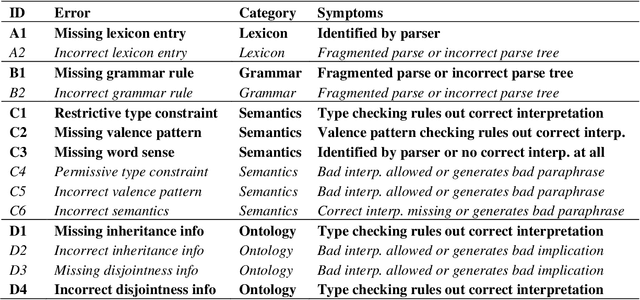
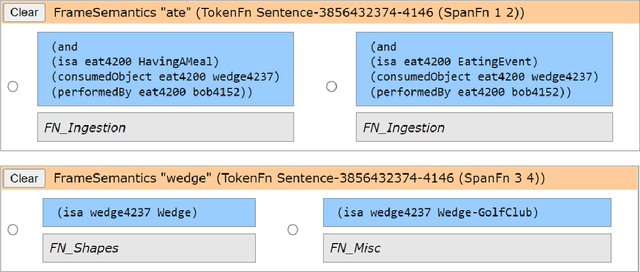

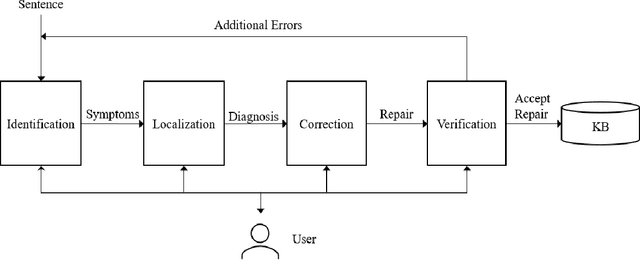
Abstract:Hand-curated natural language systems provide an inspectable, correctable alternative to language systems based on machine learning, but maintaining them requires considerable effort and expertise. Interactive Natural Language Debugging (INLD) aims to lessen this burden by casting debugging as a reasoning problem, asking the user a series of questions to diagnose and correct errors in the system's knowledge. In this paper, we present work in progress on an interactive error diagnosis system for the CNLU semantic parser. We show how the first two stages of the INLD pipeline (symptom identification and error localization) can be cast as a model-based diagnosis problem, demonstrate our system's ability to diagnose semantic errors on synthetic examples, and discuss design challenges and frontiers for future work.
Qualitative Event Perception: Leveraging Spatiotemporal Episodic Memory for Learning Combat in a Strategy Game
Jul 08, 2024Abstract:Event perception refers to people's ability to carve up continuous experience into meaningful discrete events. We speak of finishing our morning coffee, mowing the lawn, leaving work, etc. as singular occurrences that are localized in time and space. In this work, we analyze how spatiotemporal representations can be used to automatically segment continuous experience into structured episodes, and how these descriptions can be used for analogical learning. These representations are based on Hayes' notion of histories and build upon existing work on qualitative episodic memory. Our agent automatically generates event descriptions of military battles in a strategy game and improves its gameplay by learning from this experience. Episodes are segmented based on changing properties in the world and we show evidence that they facilitate learning because they capture event descriptions at a useful spatiotemporal grain size. This is evaluated through our agent's performance in the game. We also show empirical evidence that the perception of spatial extent of episodes affects both their temporal duration as well as the number of overall cases generated.
A Defeasible Deontic Calculus for Resolving Norm Conflicts
Jul 05, 2024Abstract:When deciding how to act, we must consider other agents' norms and values. However, our norms are ever-evolving. We often add exceptions or change our minds, and thus norms can conflict over time. Therefore, to maintain an accurate mental model of other's norms, and thus to avoid social friction, such conflicts must be detected and resolved quickly. Formalizing this process has been the focus of various deontic logics and normative multi-agent systems. We aim to bridge the gap between these two fields here. We contribute a defeasible deontic calculus with inheritance and prove that it resolves norm conflicts. Through this analysis, we also reveal a common resolution strategy as a red herring. This paper thus contributes a theoretically justified axiomatization of norm conflict detection and resolution.
Hybrid Primal Sketch: Combining Analogy, Qualitative Representations, and Computer Vision for Scene Understanding
Jul 05, 2024
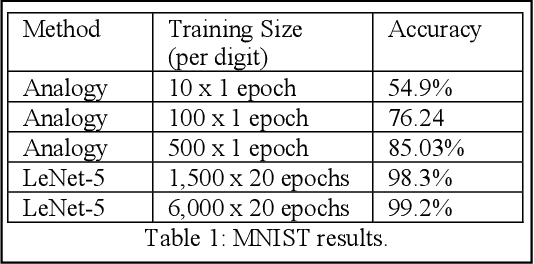
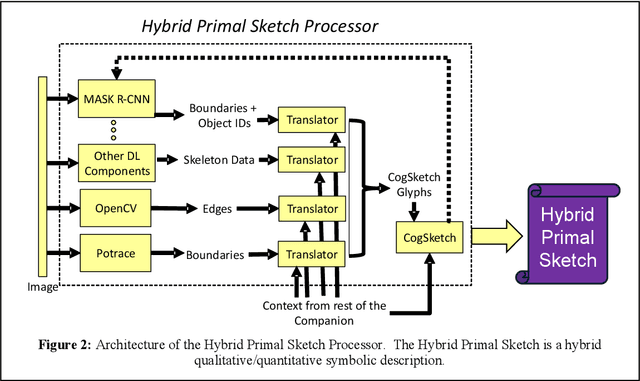
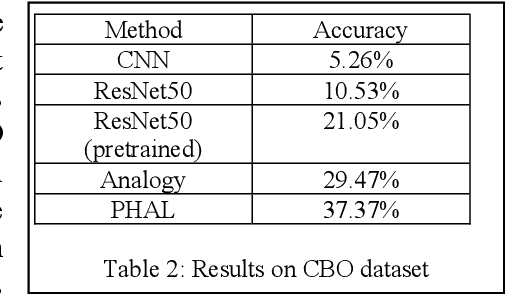
Abstract:One of the purposes of perception is to bridge between sensors and conceptual understanding. Marr's Primal Sketch combined initial edge-finding with multiple downstream processes to capture aspects of visual perception such as grouping and stereopsis. Given the progress made in multiple areas of AI since then, we have developed a new framework inspired by Marr's work, the Hybrid Primal Sketch, which combines computer vision components into an ensemble to produce sketch-like entities which are then further processed by CogSketch, our model of high-level human vision, to produce both more detailed shape representations and scene representations which can be used for data-efficient learning via analogical generalization. This paper describes our theoretical framework, summarizes several previous experiments, and outlines a new experiment in progress on diagram understanding.
Natural- to formal-language generation using Tensor Product Representations
Oct 05, 2019



Abstract:Generating formal-language represented by relational tuples, such as Lisp programs or mathematical expressions, from a natural-language input is an extremely challenging task because it requires to explicitly capture discrete symbolic structural information from the input to generate the output. Most state-of-the-art neural sequence models do not explicitly capture such structure information, and thus do not perform well on these tasks. In this paper, we propose a new encoder-decoder model based on Tensor Product Representations (TPRs) for Natural- to Formal-language generation, called TP-N2F. The encoder of TP-N2F employs TPR 'binding' to encode natural-language symbolic structure in vector space and the decoder uses TPR 'unbinding' to generate a sequence of relational tuples, each consisting of a relation (or operation) and a number of arguments, in symbolic space. TP-N2F considerably outperforms LSTM-based Seq2Seq models, creating a new state of the art results on two benchmarks: the MathQA dataset for math problem solving, and the AlgoList dataset for program synthesis. Ablation studies show that improvements are mainly attributed to the use of TPRs in both the encoder and decoder to explicitly capture relational structure information for symbolic reasoning.
Neural Symbolic Machines: Learning Semantic Parsers on Freebase with Weak Supervision
Apr 23, 2017



Abstract:Harnessing the statistical power of neural networks to perform language understanding and symbolic reasoning is difficult, when it requires executing efficient discrete operations against a large knowledge-base. In this work, we introduce a Neural Symbolic Machine, which contains (a) a neural "programmer", i.e., a sequence-to-sequence model that maps language utterances to programs and utilizes a key-variable memory to handle compositionality (b) a symbolic "computer", i.e., a Lisp interpreter that performs program execution, and helps find good programs by pruning the search space. We apply REINFORCE to directly optimize the task reward of this structured prediction problem. To train with weak supervision and improve the stability of REINFORCE, we augment it with an iterative maximum-likelihood training process. NSM outperforms the state-of-the-art on the WebQuestionsSP dataset when trained from question-answer pairs only, without requiring any feature engineering or domain-specific knowledge.
 Add to Chrome
Add to Chrome Add to Firefox
Add to Firefox Add to Edge
Add to Edge